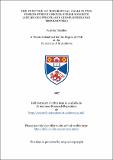Files in this item
The function of 'referential' calls in two fission-fusion species: spider monkeys (Ateles geoffroyi) and chimpanzees (Pan troglodytes)
Item metadata
| dc.contributor.advisor | Byrne, Richard W. | |
| dc.contributor.author | Teixidor, Patricia | |
| dc.coverage.spatial | 229 p. | en_US |
| dc.date.accessioned | 2018-07-09T09:35:44Z | |
| dc.date.available | 2018-07-09T09:35:44Z | |
| dc.date.issued | 1997 | |
| dc.identifier.uri | https://hdl.handle.net/10023/15095 | |
| dc.description.abstract | The problems of what primates communicate with their vocalizations and to what extent they refer to events in the external environment are raised in numerous studies of primate vocal communication. To investigate these issues, I concentrate on the calls of two primate species with a similar fission-fusion social organization. I report here the results of a one year field study on the Central American spider monkey (Ateles geoffroyi frontatus) and of a captive study on the chimpanzee (Pan troglodytes). I collected observational data and conducted playback experiments on two types of calls of the spider monkey, whinnies and alarm barks. Spider monkeys use two functionally distinct whinnies, a feeding whinny and a locational whinny. Detailed acoustic analyses of whinnies given in different contexts showed that in three females an acoustic feature-number of arches in the fundamental frequency of the call- could be used to differentiate between them. Although the whinnies of different monkeys within the same community exhibit enough acoustical differences for individual vocal recognition to take place, spider monkeys did not discriminate familiar individuals' whinnies from those of strangers from another community. In predator contexts spider monkeys use barks to attract other conspecifics to a site. However, my data do not support the existence of two types of alarm barks for aerial versus terrestrial predators. I conducted two different types of experiments on the calling behaviour of captive chimpanzees in response to food-finding. I examined whether the quantity and divisibility of food, or the presence of an audience, influence calling behaviour. Chimpanzees' food- associated calls, i.e. rough grunts, functioned to indicate food availability, and they were produced or suppressed depending on how shareable the food was and whether or not other individuals were nearly. Several spider monkeys' and chimpanzees' calls have the ability to function referentially, but cannot be considered devoid of a motivational content. | en_US |
| dc.language.iso | en | en_US |
| dc.publisher | University of St Andrews | |
| dc.subject.lcc | QL737.P93T3 | |
| dc.subject.lcsh | Cercopithecidae (Old World monkeys) | en |
| dc.title | The function of 'referential' calls in two fission-fusion species: spider monkeys (Ateles geoffroyi) and chimpanzees (Pan troglodytes) | en_US |
| dc.type | Thesis | en_US |
| dc.type.qualificationlevel | Doctoral | en_US |
| dc.type.qualificationname | PhD Doctor of Philosophy | en_US |
| dc.publisher.institution | The University of St Andrews | en_US |
This item appears in the following Collection(s)
Items in the St Andrews Research Repository are protected by copyright, with all rights reserved, unless otherwise indicated.

